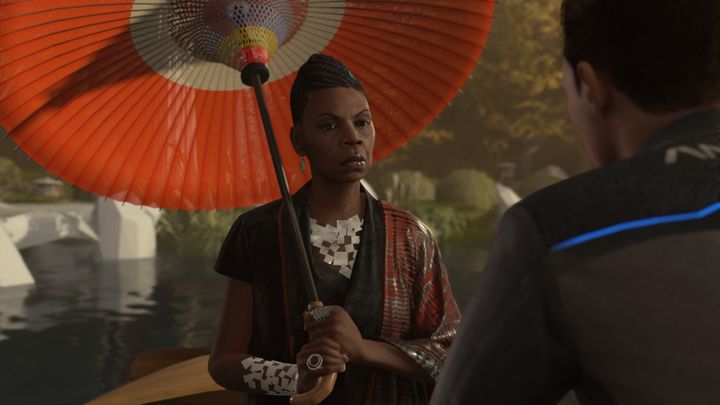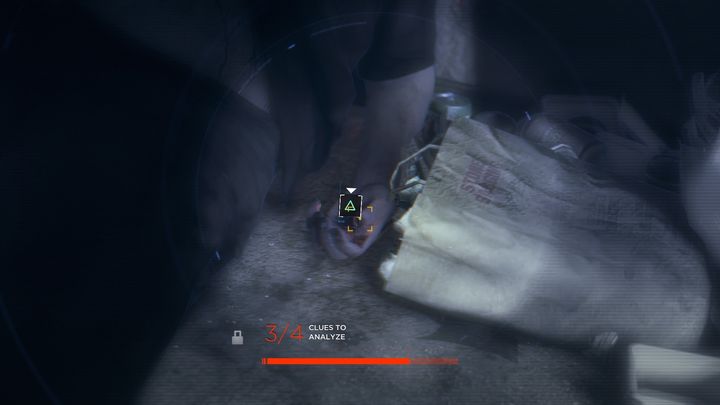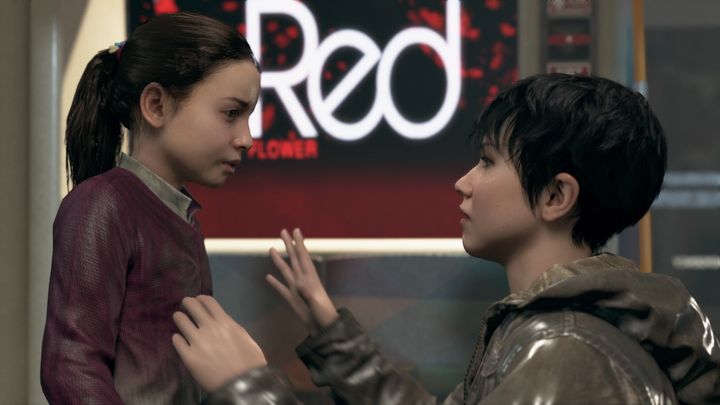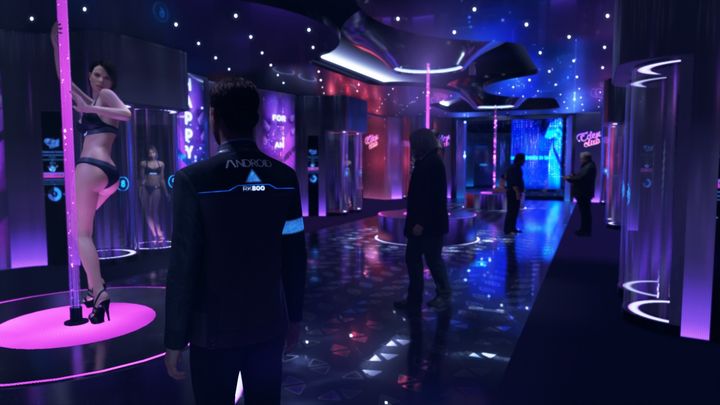In his 1968 novel Do Androids Dream of Electric Sheep? author Philip K. Dick wrote about a futuristic world in which sentient androids had gone rogue, with special human agents being dispatched to deal with the rebellious machines. This became the basis for the sci-fi movie hit Blade Runner, which saw star actor Harrison Ford hunting down rogue androids named replicants in a neon-lit city.
And now Quantic Dream, the renowned studio behind games like Indigo Prophecy, Heavy Rain and Beyond: Two Souls, has tackled the subject of what a future world with thinking androids would be like. In turn, it has delivered another good interactive adventure with a fascinating sci-fi setting and atmosphere, which nonetheless falls short of being truly great due to some gameplay issues and other quirks.
As is the case with other Quantic Dream games, you play several characters here. These include Markus, an android caretaker, and Kara, a female android servant who forms a bond with a little girl named Alice. There’s also Connor, an android detective who teams up with a human cop in order to hunt “deviants”, which are androids which have gone rogue in the game’s future Detroit.
Being a high-tech “deviant hunter”, Connor has the ability to scan people, androids and objects in order to obtain information from them. Some of his abilities are not used so often though, and while in an early scene you get to scan people sitting in a bar (which reveals their birthdate, occupation and criminal record a la Watch Dogs) you don’t actually get to do this much more throughout the game.
Crime scene analysis is a big part of what you do when playing as Connor though, and when looking at a dead body in a crime scene, there may be several clues to analyse, as you would do in a game like Rockstar’s L.A. Noire. For instance, you might discover remains of Red Ice in a victim’s mouth (an illegal drug consumed in the game’s future world) or find out how many times a poor Joe who was murdered by his android got stabbed in the chest.
Unlike L.A. Noire’s cops though, here you can see a holographic reconstruction of what went on in the crime scene once you’ve analysed all the clues. Viewing this reconstruction (which you can rewind and fast forward at leisure) yields even more clues (which you can analyse pressing the gamepad’s triangle button), eventually getting to figure out what happened at a crime scene or other useful information.
Regarding the game’s graphics, it’s clear the character models are ahead of what you find in video games these days. When Quantic Dream’s director David Cage said back in 2016 that he was looking to make the PS4 shine with Detroit: Become Human he definitely wasn’t lying, and characters here are some of the most detailed and expressive I’ve seen in a video game to date. Of course, it helps that real actors did motion capture work for the game. These include Clancy Brown, and Lance Henriksen of Alien fame, who plays an elderly painter whose caretaker is rebel-android-to-be Markus.
It’s a pity some of the characters are not as likeable as I had hoped though, and Clancy Brown’s character (a gruff cop named Hank) and his android assistant Connor are not the most charismatic cop couple in the world, to be honest. Actually, Brown and the actor playing Connor seem to be terribly miscast here, and while they are not bad characters in their own right, look like they belong in a game different from David Cage’s futuristic Detroit adventure. Other characters are more appealing though, such as a female android named North and a tall, muscle bound android named Luther who teams up with Kara and Alice later in the game.
Like in other Quantic Dream games, it’s fun to experience the story from the point of view of several characters, and while Kara is attempting to escape through the city with little girl Alice and Markus gets involved in the android rebellion, you’ll be trying to figure out who’s behind the android uprising when playing as detective android Connor. Also, being in control of several characters who are often working against each other helps keep this adventure moving at a good pace too.
The controls here work in the same manner as in Quantic Dream’s earlier games such as Indigo Prophecy and Heavy Rain: you use the left thumbstick to move your character in third person view, while the right thumbstick is used to perform actions in-game such as opening a door, for instance (opening said door might require you to push the right thumbstick forward and then counter clockwise 90 degrees, for example). This is a pretty intuitive control system that’s easy to grasp from the get-go, especially since the movements you need to perform are depicted graphically onscreen too.
This is also one of the few PS4 games to take advantage of the DualShock motion controls for performing certain actions, such as at one point in the game when you’re playing as Kara and are required to serve a drink to your new owners by tilting the gamepad to one side, for instance.
More complex actions require you to press up to four buttons at the same time. This can sometimes feel awkward, but having to press many buttons at a time does make sense when performing demanding or sleazy actions in the game, such as at one point when playing as Kara and you’re attempting to get hold of someone’s wallet in a laundry. Thankfully, the button mashing sequences players had to endure in games such as Indigo Prophecy are less stressing this time around, although like in Quantic Dream’s earlier games the QTE (Quick Time Event) action sequences are plentiful here too.
The QTE action sequences work well here, and require you to time your button presses in order to succeed. These range from taking part in a fight as Kara, to a large battle between Detroit’s military forces and the android rebels led by Markus later in the game.
Aside from the action bits, a lot of the game involves conversation with other characters, and you also get to choose between several responses when talking to others here. And as has been the case in every Quantic Dream game since Indigo Prophecy you have a limited time to respond in these, although many conversation choices don’t have any bearing on the outcome, some can make you go down one story path or another, so it pays to consider your responses carefully at points.
Your relationship with other characters is also affected by your dialogue choices, and when starting a new chapter the game will inform you of how the major characters you will be dealing with in the chapter are feeling (“tense”, “distant” or “hostile” are possibilities here) which may affect their disposition towards you and whether they will reveal certain information or not.
After completing a chapter (or scene as the game calls each of the sub-sections you play through) you’ll be presented with a flow chart showing all the possible paths and outcomes available in the chapter. As has become the norm with interactive adventures of this ilk over the years, you’ll also see what percentage of players made the same choices you did in the scene.
I couldn’t help but notice that this flow chart looks more like the kind of thing a game maker like Quantic Dream might use in the development phase of their games and less like something that might appeal to the end user (the text is quite small and scrolling is necessary to view all the branches, especially in the later, more complex scenes), but it’s still nice to know what unexplored paths there still are in the chapter in case you’re planning to replay the game later.
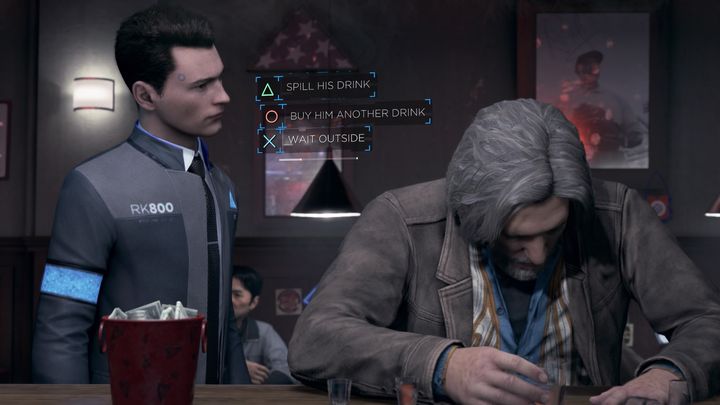
Connor’s relationship with Hank (right) is a difficult one, but you can get on the cop’s good side with the right conversation choices though.
As far as replayability is concerned, this should last you in the region of 8 to 10 hours in your first playthrough, less than that on successive playthroughs. The game’s emotional impact is diminished on a second playthrough though, especially once you’ve gotten to experience the game’s big reveal (which is quite shocking truth be told).
Also, it’s possible to replay individual chapters in order to uncover new possibilities, and get to see a different ending of the game too, of which there are several as in Quantic Dream’s earlier hit Indigo Prophecy.
Perhaps the game’s best chapter takes place in a tenebrous mansion owned by a sinister guy named Zlatko, whose intentions for protagonist Kara and Alice are not what they seem at feel glance… This bit of the game could definitely be part of a great horror movie, and it’s worth replaying if only to explore all the possibilities.
The aforementioned mansion is a memorable location, while the game also boasts several other beautifully-designed, lifelike and fantastic-looking settings. One of these is a junkyard for discarded androids, the gloomy atmosphere, rain and mechanical body parts all over the place making this a nightmarish vision of what android hell might look like.
Other great locations include an abandoned ship which serves as an android hideout, a pigeon-infested apartment (which reminded me of Hitchcock’s The Birds movie), a skyscraper lobby and the TV network offices located above are great locations. There, the android rebels hijack the broadcast room to deliver a message requesting their freedom to the world (this and an android march through the city, in which the participants chant freedom slogans are slightly cringeworthy though…).
There’s also a garden location surrounded by a pond, where our android-hunting detective Connor gets to meet his mysterious supervisor Amanda at several points in the game. These scenes sure are intriguing, and help shed light on what has been going on in the game so far.
Developer Quantic Dream has also fleshed out the game world in other ways, and I also enjoyed the news casts I got to watch on TV screens interspersed in the game world every now and then, revealing more information about the android incidents and also international world events (apparently the US is on the verge of war with Russia in Detroit’s future world…).
Also, reading e-magazines scattered throughout the game world reveals more details about the game’s future Detroit, such as the way in which people are leaving their human partners behind in favour of androids, for instance… Actually, one of the best scenes in the game takes place at an android sex club, where a deviant android murdered one of the patrons she was tending to.
Despite the spectacular production values and intriguing story though, I am not so impressed with the way the game places artificial barriers, forcing you to perform certain actions and not letting you explore at will.
Actually, at some point the game wouldn’t let me continue down a street, with a barrier popping up onscreen and a message in red letters telling me to “Comfort Alice” before I could go on, which felt jarring indeed… On another location, when walking in the park as Markus, another message appeared onscreen as I was approaching a fountain, prompting me to continue en route to my destination. This is a heavy-handed way of guiding players through the game’s locations, and is evidence of how extremely linear an experience Detroit: Become Human can be at times.
Big text messages also appear onscreen all the time telling you what to do next, and sometimes I really wished the game would let me figure things out by myself, the constant guidance becoming something of a nuisance at points.
Other gameplay limitations are annoying too, such as not being able to pick up certain objects until you actually need to use them. Such is the case in one early scene in which I was unable to pick up a crowbar lying about, until I was required to do so in order to pry open the trunk of a nearby abandoned car.
The game places far too much emphasis on mundane tasks at times too, with the game requiring your input for everything, such as drinking from a bottle. Plus, getting to perform housekeeping tasks as Kara early on sometimes felt as tedious as the real thing too…
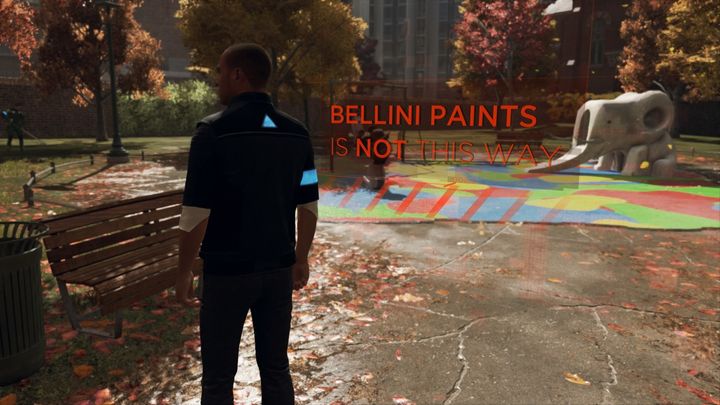
Detroit’s artificial barriers and reminders of having to do something else before proceeding can get annoying at times.
And while playing both the deviant-hunting cops and the renegade android themselves is interesting here, and you get to play both sides in one pretty exciting QTE chase sequence next to a highway, it’s a pity that sometimes the highs are followed by lows, and after the chase there follows a slightly tedious and overlong chapter in which you have to look for strange symbols on walls in order to reach an android hideout.
Despite its issues, though, Detroit: Become Human manages to rise above its faults and ends up being a very good adventure game. From the little details such as the way characters avoid stepping on objects scattered on the floor at a crime scene, to the fabulously detailed locations, interesting characters and multi-layered story, this is one of the best adventure games of the year so far. This might not be Quantic Dream’s best game to date then, but sure is one worth experiencing no doubt.
Detroit: Become Human
Score: 75 / 100
Available on: PS4
Publisher: Sony Interactive Entertainment
Launch date: May 25, 2018

